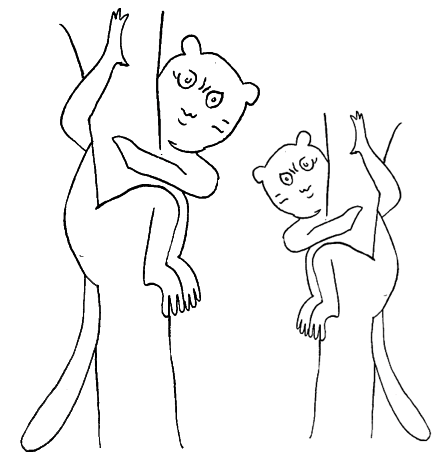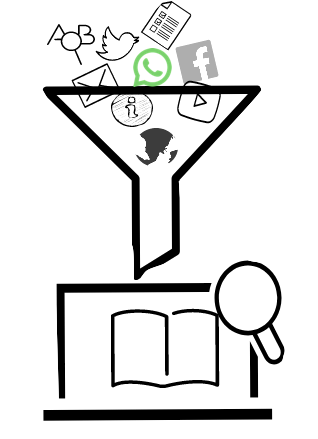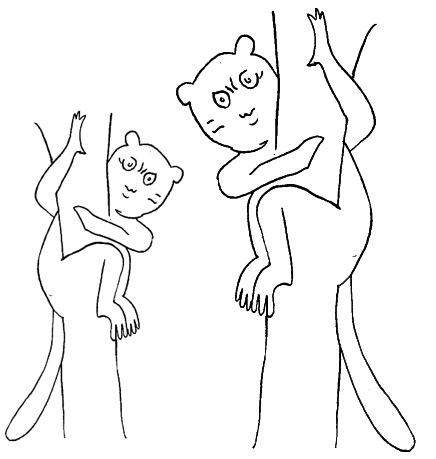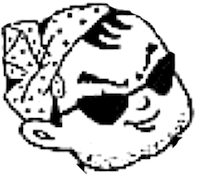


キュレーションとコンテンツ・キュレーション
Curation and Contents
curation
★ キュレーション(curation)とは、博物館や資料館における、資料の収集プロセスのこと全般をさす言葉である。すなわち、コレクションや展示のアイ テムを選択し、整理し、世話をする行為またはプロセスのことをさす。収集行為と整理の過程は、アマチュアの昆虫採集と標本作成、資料整理、および、保管の プロセスを思い起こせば、基本的に大きな異同はない。すなわち、収集計画、収集器具の取り揃えと整備、収集旅行と採集、捕獲記録と殺処理、資料の乾燥や防 腐処理、展翅(てんし)などの標本化への準備、種の同定と捕獲情報の照合、標本箱への保管と管理、定期点検や収集物のコレクター間での交換や売買など、の 一連の作業がある。これらの行為は、すべてキュレーションとよばれる。昆虫採集と、博物館や資料館などは、何を収集保管するかで、そのプロセス管理の具体 的手法がそれぞれ異なってくる。
それに対して、インターネットの普及は、上掲のアナログ的事物のキュレーションの他に、デジ
タル化の情報のキュレーションという概念を発達させた。それがコンテンツキュレーション(Content curation)
という概念である。コンテンツ・キュレーションとは、特定の話題や関心分野に関連する情報を収集するプロセスで、通常、コレクションや展示のアイテムを選
択、整理、世話するプロセスを通じて価値を高めることを意図している[1]。コンテンツ・キュレーションを実施するサービスや人はキュレーターと呼ばれて
いる。キュレーションサービスは、エンドユーザーだけでなく、企業でも使われることがある。
現在では、アナログ〈対〉デジタルという単純な対立 図式だけでは、キュレーションの概念が十分に整理しきれない。なぜなら、従前のアナログ自分のキュレーションに、既存のICT技術はどんどんデジタル化の 度合いを加速化しているからである。実際に、博物館や美術館には、収蔵品や展示品の選定や解説を行うキュレーターがいる。また、メディアの世界にもキュ レーターが存在し、例えばラジオ局のDJは、放送で流す曲を選ぶ仕事をしている。
コンテンツのキュレーションは、手動または自動、あ
るいはそれらの組み合わせで実施される。最初のケースでは、特別に指定されたキュレーターによって行われます。2つ目のケースでは、以下の1つまたは複数
を使用して行われる:
協調フィルタリング(Collaborative filtering)
協調フィルタリングは、推薦システムでよく使われる
予測手法の一つである。この原理は、過去にユーザーが行った評価は、将来ユーザーが行うであろう評価を予測するという公理に基づいている。協調フィルタリ
ングは、RedditやDiggのように特定のソーシャルコミュニティの投票やビューに基づくものと、YouTubeやAmazonのようにエンドユー
ザー自身の過去のアクティビティに基づくものが存在する。
セマンティック解析(Semantic analysis)
意味解析(セマンティック解析)は、与えられた文書
の中で見つけた様々な要素や情報源の関係を調べるものである。このシステムでは、一部の要素またはすべての情報源のトピックや用語を比較する。この方法
は、因子分析の原理を利用して、研究された現象や対象物の間の関係を分析するものである。この手法は、トピック、サブトピック、カテゴリーに従ってコンテ
ンツを分割するStumbleuponのようなサービスによって成功裏に実装されている。Trapitは、意味解析とユーザーからのフィードバック、AI
技術を組み合わせて、ユーザーのためにコンテンツの選択を洗練させるために使われている。
社会的評価(Social rating)
この方法は、コンテンツを選択するために、ユーザー
の評価と推薦を採用しています。エンドユーザーと同じような興味を持つ人を見つけ、そのアクティビティに基づき推薦を行う。この選定方法は、
FacebookやFlipboardなどのソーシャルサイトで広く使われている。ソーシャルランキングを決定するためのパラメータは、一般的に、シェ
ア、投票、いいね!などのアクションに基づいており、これらの活動がコンテンツが公開されてから実行される時間を念頭に置いている。短時間にこのような活
動が多ければ多いほど、このコンテンツは高い評価を得ることができる。Pinterestのような「ソーシャルキュレーション」サービスでは、ユーザーが
見つけたコンテンツのキュレーションコレクションを共有し、議論することができる。
+++
| Digital curation
is the selection,[1] preservation, maintenance, collection, and
archiving of digital assets.[2][3][4][5] Digital curation establishes,
maintains, and adds value to repositories of digital data for present
and future use.[4] This is often accomplished by archivists,
librarians, scientists, historians, and scholars.[6] Enterprises are
starting to use digital curation to improve the quality of information
and data within their operational and strategic processes.[7]
Successful digital curation will mitigate digital obsolescence, keeping
the information accessible to users indefinitely.[8] Digital curation
includes digital asset management, data curation, digital preservation,
and electronic records management.[9] |
デジタルキュレーションとは、デジタル資産の選択、[1]保存、維持、
収集、アーカイブのことである[2] [3] [4] [5]
デジタルキュレーションは、現在および将来の使用のためにデジタルデータのリポジトリを確立、維持、および付加価値を与える[4]
これはしばしば、アーカイブ、司書、科学、歴史家および学者によって成し遂げられる。
[デジタルキュレーションは、デジタル資産管理、データキュレーション、デジタル保存、電子記録管理などを含む[8]。 |
| Much like the word archive has
layered meanings and uses, the word curation is both a noun and a verb
used originally in the field of museology to represent a wide range of
activities, most often associated with collection care, long-term
preservation, and exhibition design. Curation can be a reference to
physical repositories that store cultural heritage or natural resource
collections (e.g., a curatorial repository) or a representation of
varied policies and processes involved with the long-term care and
management of heritage collections, digital archives, and research data
(e.g, curatorial/collections management plans, curation life-cycle, and
data curation). Yet curation is also associated with short-term
objectives and processes of selection and interpretation for the
purposes of presentation, such as for gallery exhibitions and websites,
which contribute to knowledge creation. It has also been applied to
interaction with social media including compiling digital images, web
links, and movie files. The term curation entered the legal framework through federal historic preservation laws, starting with the National Historic Preservation Act of 1966,[10] and was further defined and coded into federal regulations through 36 CFR Part 79: Curation of Federally-owned and Administered Archaeological Collections.[11] Curation has since permeated into an array of disciplines but remains closely tied to heritage and information managemen |
アーカイブという言葉に重層的な意味や使い方があるように、キュレー
ションという言葉も、元々は博物館学の分野で使われる名詞と動詞の両方で、コレクションの管理、長期保存、展示デザインに関連する幅広い活動を表すことが
ほとんどである。キュレーションは、文化遺産や天然資源のコレクションを保管する物理的なリポジトリ(例:キュレーターリポジトリ)、または遺産コレク
ション、デジタルアーカイブ、研究データの長期的なケアと管理に関わる様々な方針とプロセス(例:キュレーター/コレクション管理計画、キュレーションの
ライフサイクル、データキュレーション)を表すことができます。しかし、キュレーションは、ギャラリーでの展示やウェブサイトなど、プレゼンテーションの
ための選択と解釈という短期的な目的とプロセスにも関連し、知識の創造に貢献する。また、デジタル画像、ウェブリンク、ムービーファイルの編集など、ソー
シャルメディアとの相互作用にも適用されている。 キュレーションという用語は、1966年の(米国の)国家歴史保存法に始まる連邦歴史保存法を通じて法的枠組みに入り[10]、さらに36 CFR Part 79を通じて連邦規則に定義・コード化された: その後、キュレーションは様々な分野に浸透していったが、現在でも遺産や情報管理と密接に関連している。 |
| The term "digital curation" was
first used in the e-science and biological science fields as a means of
differentiating the additional suite of activities ordinarily employed
by library and museum curators to add value to their collections and
enable its reuse[12][13][14] from the smaller subtask of simply
preserving the data, a significantly more concise archival task.[12]
Additionally, the historical understanding of the term "curator"
demands more than simple care of the collection. A curator is expected
to command academic mastery of the subject matter as a requisite part
of appraisal and selection of assets and any subsequent adding of value
to the collection through application of metadata.[12] |
「デジタルキュレーション」という用語は、電子科学や生物科学の分野
で、コレクションに価値を与え、その再利用を可能にするために図書館や博物館のキュレーターが通常採用する一連の追加活動を、単にデータを保存するという
小さなサブタスク(著しく簡潔なアーカイブ作業)と区別する手段として初めて使われた[12][13][14]。さらに、「キュレーター」という用語の歴
史的理解はコレクションの単なる管理以上のものを求めている。キュレーターは、資産の評価と選択、およびその後のメタデータの適用によるコレクションの価
値の付加に必要な部分として、主題に関する学問的熟達を要求される[12]。 |
| There are five commonly accepted
principles that govern the occupation of digital curation: Manage the complete birth-to-retirement life cycle of the digital asset.[5] Evaluate and cull assets for inclusion in the collection.[5] Apply preservation methods to strengthen the asset’s integrity and reusability for future users.[5] Act proactively throughout the asset life cycle to add value to both the digital asset and the collection.[5] Facilitate the appropriate degree of access to users.[5] |
デジタルキュレーションという職業を支配する、一般的に受け入れられて
いる5つの原則がある: デジタル資産の誕生から引退までのライフサイクルを完全に管理する[5]。 コレクションに含めるための資産を評価し、選別する[5]。 保存方法を適用して、資産の完全性と将来のユーザーに対する再利用性を強化する[5]。 デジタル資産とコレクションの両方に価値を与えるため、資産のライフサイクルを通じて積極的に行動する[5]。 ユーザーへの適切な程度のアクセスを容易にする[5]。 |
| Methodology. |
(略) |
| The term "digital curation" is
sometimes used interchangeably with terms such as "digital
preservation" and "digital archiving."[2][16] While digital
preservation does focus a significant degree of energy on optimizing
reusability, preservation remains a subtask to the concept of digital
archiving, which is in turn a subtask of digital curation.[12][14] For
example, archiving is a part of curation, but so are subsequent tasks
such as themed collection-building, which is not considered an archival
task. Similarly, preservation is a part of archiving, as are the tasks
of selection and appraisal that are not necessarily part of
preservation.[14] Data curation is another term that is often used interchangeably with digital curation, however common usage of the two terms differs. While "data" is a more all-encompassing term that can be used generally to indicate anything recorded in binary form, the term "data curation" is most common in scientific parlance and usually refers to accumulating and managing information relative to the process of research.[17] Data-driven research of education request the role of information professional gradually develop tradition of digital service to data curation particularly at the management of digital research data.[18] So, while documents and other discrete digital assets are technically a subset of the broader concept of data,[12] in the context of scientific vernacular digital curation represents a broader purview of responsibilities than data curation due to its interest in preserving and adding value to digital assets of any kind.[13] |
デジタル・キュレーション」という用語は、「デジタル保存」や「デジタ
ル・アーカイブ」といった用語と互換的に使われることがある[2][16]。デジタル保存は再利用性の最適化にかなりのエネルギーを注ぐが、保存はデジタ
ル保存という概念のサブタスクであり続け、それはデジタルキュレーションのサブタスクとなる[12][14]。例えば、アーカイブはキュレーションの一部
だが、アーカイブ作業とはみなされないテーマ別のコレクション構築といった後続作業も同じようにキュレーションの一部となる。同様に、保存はアーカイブの
一部であり、保存の一部とは限らない選択と評価のタスクもアーカイブの一部である[14]。 データキュレーションは、デジタルキュレーションと同じ意味で使われることが多い言葉であるが、一般的な使われ方は異なる。データ」はより包括的な用語で あり、バイナリ形式で記録されたあらゆるものを示すために一般的に使われることができるが、「データキュレーション」という用語は科学用語で最も一般的で あり、通常、研究のプロセスに関連する情報の蓄積と管理を指す[17][18] データ駆動型の教育研究は、情報専門家の役割を要求し、特にデジタル研究データの管理におけるデータキュレーションのデジタルサービスの伝統を徐々に発展 させている。 [18]したがって、文書やその他の個別のデジタル資産は、技術的にはデータという広い概念のサブセットであるが[12]、科学用語の文脈では、デジタル キュレーションは、あらゆる種類のデジタル資産を保存し価値を付加するという関心から、データキュレーションよりも幅広い責任の範囲を表している [13]。 |
| Rate of creation of new data and
data sets The ever lowering cost and increasing prevalence of entirely new categories of technology has led to a quickly growing flow of new data sets.[19] These come from well established sources such as business and government, but the trend is also driven by new styles of sensors becoming embedded in more areas of modern life.[13] This is particularly true of consumers, whose production of digital assets is no longer relegated strictly to work. Consumers now create wider ranges of digital assets, including videos, photos, location data, purchases, and fitness tracking data, just to name a few, and share them in wider ranges of social platforms.[13] Additionally, the advance of technology has introduced new ways of working with data. Some examples of this are international partnerships that leverage astronomical data to create "virtual observatories," and similar partnerships have also leveraged data resulting from research at the Large Hadron Collider at CERN and the database of protein structures at the Protein Data Bank.[14] |
新しいデータおよびデータセットの作成率 この傾向は、企業や政府といった確立された情報源だけでなく、新しいスタイルのセンサーが現代生活のより多くの領域に組み込まれていることにも起因してい る[13]。これは特に消費者に当てはまり、消費者によるデジタル資産の作成は、もはや仕事だけに限定されたものではなくなっている。消費者は現在、ビデ オ、写真、位置情報、購買、フィットネス・トラッキング・データなど、より幅広いデジタル資産を作成し、より幅広いソーシャル・プラットフォームでそれら を共有している[13]。 また、テクノロジーの進化により、データを活用する新たな手法も登場している。例えば、天文学のデータを活用して「バーチャル天文台」を作る国際的なパー トナーシップや、CERNの大型ハドロン衝突型加速器の研究成果やプロテイン・データバンクのタンパク質構造データベースを活用した同様のパートナーシッ プもある[14]。 |
| Storage format evolution and
obsolescence By comparison, archiving of analog assets is notably passive in nature, often limited to simply ensuring a suitable storage environment.[2] Digital preservation requires a more proactive approach.[20] Today’s artifacts of cultural significance are notably transient in nature and prone to obsolescence when social trends or dependent technologies change.[13] This rapid progression of technology occasionally makes it necessary to migrate digital asset holdings from one file format to another in order to mitigate the dangers of hardware and software obsolescence which would render the asset unusable.[15][8] |
ストレージフォーマットの進化と陳腐化 それに比べ、アナログ資産のアーカイブは受動的な性質が強く、適切な保存環境を確保するだけに留まることが多い[2]。デジタル保存には、より積極的なア プローチが必要である[20]。今日の文化的意義を持つ芸術品は、社会動向や依存技術の変化により陳腐化する傾向があり、特に一過性である。 このような技術の急速な進歩により、デジタル資産を保有する場合、ハードウェアやソフトウェアの陳腐化によって資産が使用できなくなる危険性を軽減するた めに、あるファイル形式から別のファイル形式への移行が必要になることがある[13][15][8]。 |
| Underestimation of human labor
costs Modern tools for program planning often underestimate the amount of human labor costs required for adequate digital curation of large collections. As a result cost-benefit assessments often paint an inaccurate picture of both the amount of work involved and the true cost to the institution for both successful outcomes and failures.[13] The concept of cost in business field would be more obvious. Varieties of business systems are running for daily operations. For example, human resources systems deal with recruitment and payroll, communication systems manage internal and external email, and administration systems handle finance, marketing, and other aspects. However, business systems in institutions are not designed for long-term information preservation initially.[21] In some instances, business systems are revised to become Digital Curation systems for preserving transaction information due to cost consideration. The example of business systems are Enterprise Content Management (ECM) applications, which are used by designated group people such as business executives, customers for information management that support key processes organizationally. In the long run, to transfer digital content from ECM applications to Digital Curation (DC) applications would be a trend in large organizations domestically or internationally. The improvement of maturity models of ECM and DC may add value to information that request cost deduction and extensive use for further modification.[21] |
人的人件費の過少見積もり プログラム計画のための最新のツールは、大規模コレクションの適切なデジタルキュレーションに必要な人的コスト を過小評価しがちである。その結果、費用対効果の評価では、成功した場合も失敗した場合も、関係する作業量と機関への真のコストの両方について不正確なイ メージを描くことが多い[13]。 ビジネスシーンにおけるコストの概念は、より明確なものであるはずである。日々の業務では、さまざまな業務システムが稼働している。例えば、人事システム は採用や給与計算を、コミュニケーションシステムは社内外のメールを管理し、管理システムは財務やマーケティングなどを担当している。しかし、機関の業務 システムは、当初は長期的な情報保存を前提に設計されていない[21]。コスト面を考慮して、業務システムを取引情報を保存するためのデジタルキュレー ションシステムに改めるケースもある。業務システムの例としては、企業コンテンツ管理(ECM)アプリケーションがあり、経営者や顧客など特定のグループ によって、組織的に重要なプロセスをサポートする情報管理のために使われている。長期的には、デジタルコンテンツをECMアプリケーションからデジタル キュレーション(DC)アプリケーションに移行することが、国内外の大企業におけるトレンドとなる。ECMとDCの成熟度モデルを改善することで、コスト 削減を要求する情報に価値を与え、さらに修正するために広範囲に利用できるようになるかもしれない[21]。 |
| Digitization of analog materials The curation of digital objects is not limited to strictly born-digital assets. Many institutions have engaged in monumental efforts to digitize analog holdings in an effort to increase access to their collections.[2] Examples of these materials are books, photographs, maps, audio recordings, and more.[13] The process of converting printed resources into digital collections has been epitomized to some degree by librarians and related specialists. For example, The Digital Curation Centre is claimed to be a "world leading centre of expertise in digital information curation"[24] that assists higher education research institutions in such conversions. |
アナログ資料のデジタル化 デジタルオブジェクトのキュレーションは、厳密に言えば、生まれながらのデジタル資産に限定されるものではない。多くの機関が、コレクションへのアクセス を向上させるために、アナログの所蔵物をデジタル化するという大規模な取り組みを行っている[2]。 これらの資料の例としては、書籍、写真、地図、オーディオ録音などがある[13]。印刷物をデジタルコレクションに変換するプロセスは、司書や関連専門家 によってある程度典型的に表現されている。例えば、デジタル・キュレーション・センターは、「デジタル情報キュレーションにおける世界有数の専門セン ター」[24]として、高等教育研究機関のこうした変換を支援しているとされている。 |
| New representational formats For some topics, knowledge is embodied in forms that have not been conducive to print, such as how choreography of dance or of the motion of skilled workers or artisans is difficult to encode. New digital approaches such as 3D holograms and other computer-programmed expressions are developing.[citation needed] For mathematics, it seems possible for a new common language to be developed that would express mathematical ideas in ways that can be digitally stored, linked, and made accessible. The Global Digital Mathematics Library is a project to define and develop such a language.[26][27] |
新しい表現形式 トピックによっては、ダンスの振り付けや熟練工や職人の動作がいかに符号化しにくいかなど、これまで印刷に適さない形で知識が具現化されています。3Dホ ログラムなど、コンピューターでプログラムされた表現など、新しいデジタルアプローチが発展している[引用者注釈]。 数学については、数学的な考え方をデジタルで保存、リンク、アクセス可能な方法で表現する新しい共通言語を開発することが可能であると思われます。 Global Digital Mathematics Libraryは、そのような言語を定義し開発するプロジェクトである[26][27]。 |
| Accessibility The ability of the intended user community to access the repository’s holdings is of equal importance to all the preceding curatorial tasks. This must take into account not only the user community’s format and communication preferences, but also a consideration of communities that should not have access for various legal or privacy reasons.[28] Access can be increased by providing information about open access status with open data and open source methods such as the OAI-PMH endpoints of an open archive, which are then aggregated by databases and search engines like BASE, CORE, and Unpaywall for academic papers.[29] |
アクセシビリティ 想定されるユーザーコミュニティがリポジトリの所蔵品にアクセスできることは、先のすべてのキュレーターの仕事と同等の重要性を持つ。これは、ユーザーコ ミュニティのフォーマットやコミュニケーションの好みだけでなく、様々な法的理由やプライバシー上の理由からアクセスできないはずのコミュニティについて も考慮しなければならない[28]。 オープンアーカイブのOAI-PMHエンドポイントなど、オープンデータやオープンソースの手法でオープンアクセス状況の情報を提供し、それをBASEや CORE、Unpaywallなどのデータベースや検索エンジンで学術論文に集約することでアクセスを増やすことができる[29]。 |
| Responses to challenges Specialized research institutions[30][31] There are three elements for essential needs of institutions dealing with issues of digital curation: Leadership, Resources, and Collaboration. Three elements related to the role of advance-guards for librarians and archivists working with open approaches to technology, standardized process and scholarly communication. The archivist with leadership, who needs to be a dynamic and active role to embrace technology, standardized process, and scholarly communication. In addition, Archivist leader might adopt the business concept and methods to deal with their workflow such as raise funds, invest technology system, and comply with industry standards, in order to obtain more resources. Collaboration in archives and digital curation community could provide and share training, technologies, standards, and tools to help institutions on challengeable issues of digital curation. Digital Preservation Coalition (DPC), the Open Preservation Foundation or novel partnerships offer collaboration opportunity to institutions facing similar challenges in digital curation issues.[32] Academic courses Information field especially in libraries, archives, and museums significantly need to bring knowledge of new technologies. Traditional graduate school education is not enough to meet that demand; training program for current staffs in cultural repository would be an efficient supplement for that request, such as professional workshops, and MOOCs (Massively Open Online Courses) in data curation and management.[33] Dedicated symposia[34][35] International Digital Curation Conference (IDCC) is an established annual event since 2005, aiming to collaborate with individuals, organizations, and institutions facing challenges, supporting development, and exchanging ideas in the field.[36] Peer reviewed technical and industry journals[37] The International Journal of Digital Curation (IJDC) is administered by IJDC Editorial Board including the Editor-in-Chief, Digital Curation Center (DCC), and the following members. IJDC dedicate to provide scholarly platform for sharing, discussing, and improving knowledge and information of digital curation within the worldwide community. IJDC has two types of submission under editorial guidelines, which are peer-reviewed papers and general articles base on original research, the field information, and relevant events in digital curation. IJDC is published by the University of Edinburgh for the Digital Curation Centre in electronic form on a rolling basis two times a year. The open access to the public supports knowledge exchangeable in digital curation worldwide.[38] |
課題への対応 デジタルキュレーションの問題に取り組む機関の本質的なニーズには、3つの要素がある: リーダーシップ」「リソース」「コラボレーション」です。テクノロジー、標準化されたプロセス、学術コミュニケーションへのオープンなアプローチに取り組 むライブラリアンやアーキビストの前衛的な役割に関連する3つの要素である。リーダーシップのあるアーキビストは、テクノロジー、標準化されたプロセス、 学術的コミュニケーションを受け入れるために、ダイナミックでアクティブな役割を果たす必要がある人である。また、アーキビストのリーダーは、より多くの リソースを得るために、資金調達、技術システム投資、業界標準への準拠など、ビジネスコンセプトやワークフローに対応する方法を採用することがある。アー カイブズとデジタル・キュレーションのコミュニティにおけるコラボレーションは、トレーニング、技術、標準、ツールを提供し、共有することで、デジタル・ キュレーションの困難な問題に対して機関を支援することができる。Digital Preservation Coalition(DPC)、Open Preservation Foundation、または新しいパートナーシップは、デジタルキュレーションの問題で同様の課題に直面している機関にコラボレーションの機会を提供す る[32]。 アカデミックコース 情報分野、特に図書館、アーカイブズ、ミュージアムの分野では、新しいテクノロジーの知識を身につけることが求められている。従来の大学院での教育ではそ の要求に応えるには不十分であり、文化リポジトリの現役スタッフに対するトレーニングプログラムは、専門的なワークショップや、データキュレーションや管 理に関するMOOC(Massively Open Online Courses)など、その要求を効率的に補うものとなるであろう[33]。 専用シンポジウム[34][35]。 国際デジタルキュレーション会議(IDCC)は、2005年から毎年開催されているイベントで、この分野で課題に直面し、開発を支援し、アイデアを交換す る個人、組織、機関とのコラボレーションを目的としている[36]。 査読付き技術・業界誌[37]。 International Journal of Digital Curation (IJDC)は、編集長、デジタル・キュレーション・センター(DCC)、および以下のメンバーを含むIJDC編集委員会により運営されている。IJDC は、デジタル・キュレーションに関する知識や情報を世界中のコミュニティで共有し、議論し、改善するための学術的なプラットフォームを提供することに専念 している。IJDCは、編集ガイドラインに基づき、査読付き論文と、オリジナル研究、現場情報、デジタル・キュレーションの関連イベントに基づく一般記事 の2種類の投稿が可能です。IJDCは、エジンバラ大学デジタル・キュレーション・センターから年2回、電子媒体で発行される。一般に公開されているた め、世界中のデジタル・キュレーションに関する知識の交換が可能である[38]。 |
| Approaches Many approaches to digital curation exist and have evolved over time in response to the changing technological landscape. Two examples of this are sheer curation[12] and channelization.[citation needed] Sheer curation is an approach to digital curation where curation activities are quietly integrated into the normal work flow of those creating and managing data and other digital assets. The word sheer is used to emphasize the lightweight and virtually transparent nature of these curation activities. The term sheer curation was coined by Alistair Miles in the ImageStore project,[39] and the UK Digital Curation Centre's SCARP project.[40] The approach depends on curators having close contact or 'immersion' in data creators' working practices. An example is the case study of a neuroimaging research group by Whyte et al., which explored ways of building its digital curation capacity around the apprenticeship style of learning of neuroimaging researchers, through which they share access to datasets and re-use experimental procedures.[41] Sheer curation depends on the hypothesis that good data and digital asset management at the point of creation and primary use is also good practice in preparation for sharing, publication and/or long-term preservation of these assets. Therefore, sheer curation attempts to identify and promote tools and good practices in local data and digital asset management in specific domains, where those tools and practices add immediate value to the creators and primary users of those assets. Curation can best be supported by identifying existing practices of sharing, stewardship, and re-use that add value, and augmenting them in ways that both have short-term benefits, and in the longer term reduce risks to digital assets or provide new opportunities to sustain their long-term accessibility and re-use value.[citation needed] The aim of sheer curation is to establish a solid foundation for other curation activities which may not directly benefit the creators and primary users of digital assets, especially those required to ensure long-term preservation. By providing this foundation, further curation activities may be carried out by specialists at appropriate institutional and organisation levels, whilst causing the minimum of interference to others.[citation needed] A similar idea is curation at source used in the context of Laboratory Information Management Systems LIMS. This refers more specifically to automatic recording of metadata or information about data at the point of capture and has been developed to apply semantic web techniques to integrate laboratory instrumentation and documentation systems.[42] Sheer curation and curation-at-source can be contrasted with post hoc digital preservation, where a project is initiated to preserve a collection of digital assets that have already been created and are beyond the period of their primary use.[citation needed] Channelization is curation of digital assets on the web, often by brands and media companies, into continuous flows of content, turning the user experience from a lean-forward interactive medium, to a lean-back passive medium. The curation of content can be done by an independent third party, that selects media from any number of on-demand outlets from across the globe and adds them to a playlist to offer a digital "channel" dedicated to certain subjects, themes, or interests so that the end user would see and/or hear a continuous stream of content.[citation needed] https://en.wikipedia.org/wiki/Digital_curation |
アプローチ デジタル・キュレーションには多くのアプローチが存在し、技術的な状況の変化に対応して、時代とともに進化してきた。その2つの例がシアーキュレーション [12]とチャネライゼーションである[引用者注釈]。 シアーカレーションとは、データやその他のデジタル資産を作成・管理する人たちの通常のワークフローに、キュレーション活動を静かに組み込むデジタルキュ レーションのアプローチである。シアーという言葉は、このようなキュレーション活動の軽量さと事実上の透明性を強調するために使われている。シアーキュ レーションという言葉は、ImageStoreプロジェクト[39]やUKデジタルキュレーションセンターのSCARPプロジェクト[40]で Alistair Milesによって作られた。このアプローチは、キュレーターがデータ作成者の作業習慣に密接に接触したり「没頭」することに依存する。Whyteらによ る神経画像研究グループの事例では、神経画像研究者がデータセットへのアクセスを共有し、実験手順を再利用するという徒弟制度のような学習スタイルを中心 に、デジタルキュレーションの能力を構築する方法を検討した[41]。 シアワセキュレーションは、データやデジタル資産の作成時や一次利用時の優れた管理は、共有、公開、長期保存の準備においても優れた実践であるという仮説 に基づいている。したがって、シアキュレーションは、特定の領域におけるローカルデータとデジタル資産管理のツールやグッドプラクティスを特定し、促進す ることを試みるもので、それらのツールやプラクティスは、それらの資産のクリエイターや主要ユーザーに直接的な価値を付加する。キュレーションは、価値を 高める共有、スチュワードシップ、再利用の既存の実践を特定し、短期的には利益をもたらし、長期的にはデジタル資産に対するリスクを軽減したり、長期的な アクセシビリティや再利用価値を維持するための新しい機会を提供する方法で、それらを補強することで最もよくサポートできる[citation needed]。 シアーキュレーションの目的は、デジタル資産の作成者や主要な利用者に直接利益をもたらさないかもしれない他のキュレーション活動、特に長期保存を確実に するために必要なキュレーション活動のための強固な基盤を確立することである。この基盤を提供することで、他者への干渉を最小限に抑えながら、適切な機関 や組織レベルの専門家がさらなるキュレーション活動を行うことができる[citation needed]。 同様の考え方に、ラボラトリー情報管理システムLIMSの文脈で使われるキュレーション・アット・ソースがある。これは、より具体的には、データを取得し た時点でメタデータまたはデータに関する情報を自動的に記録することを指し、セマンティックウェブ技術を適用して実験室機器と文書システムを統合するため に開発されている[42]。シアーキュレーションとキュレーションアットソースは、ポストホックデジタル保存(既に作成されており、その主要使用期間を超 えているデジタル資産のコレクションを保存するためにプロジェクトを開始)とは対比されることがある[citation needed] 。 チャンネル化とは、ウェブ上のデジタル資産を、多くの場合、ブランドやメディア企業によって、継続的なコンテンツの流れにキュレーションすることで、ユー ザー体験を、前傾姿勢のインタラクティブなメディアから、後傾姿勢のパッシブなメディアへと変化させることである。コンテンツのキュレーションは、独立し た第三者によって行われ、世界中のあらゆる数のオンデマンド・アウトレットからメディアを選択し、それらをプレイリストに追加して、特定の主題、テーマ、 または興味に特化したデジタル「チャンネル」を提供し、エンドユーザーがコンテンツの連続した流れを見たり聞いたりすることができる[citation needed] 。 |
Links
リンク
文献
その他の情報


Copyleft,
CC, Mitzub'ixi Quq Chi'j, 1996-2099